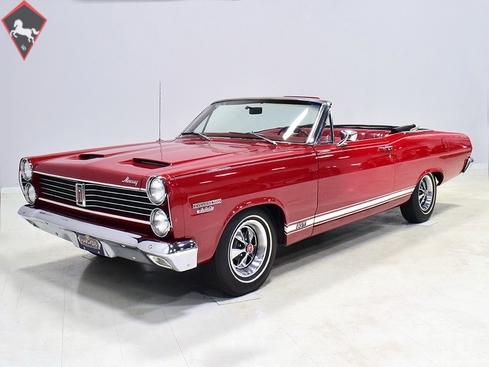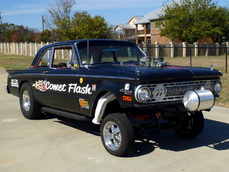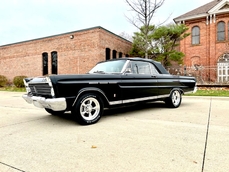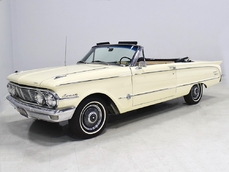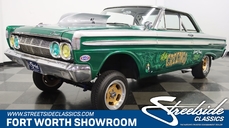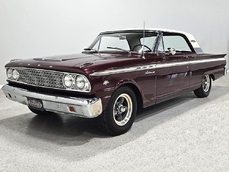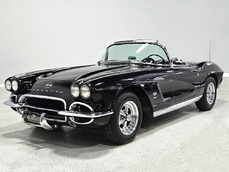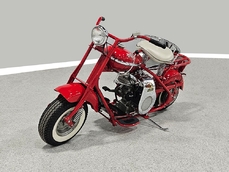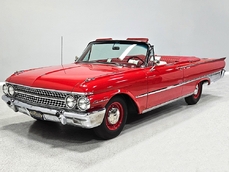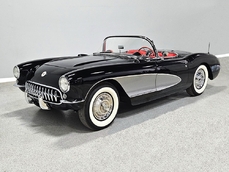Mercury Comet 390 cubic inch V8 1967
Allgemeine Beschreibung :
The name might be a bit cumbersome—Mercury Comet Cyclone GT convertible—but the car is flat-out incredible. In 1966 the Comet moved up a size and was now a cousin to the mid-sized Fairlane rather than the compact Falcon. This, of course, had the side benefit of allowing big block V8s to easily fit under the hood, which was surely the point. Mercury needed some flash in the showroom and the Cyclone GT delivered in a big way. The GT was more a competitor for the Olds 442 and Buick GS, bringing big power with a softer edge and a more upscale personality—make no mistake, this was an expensive car. But despite serious performance and those handsome good looks, only 378 GT convertibles were built in 1967 and this might just be the best of them all. It offers incredible preservation, a known history back to new, a California pedigree, and a great story. What else could you want from a collector car?
This phenomenally well-preserved 1967 Mercury Comet Cyclone GT convertible has had just two owners from new and spent the first 45 years of its life in sunny California. The original owner was a judge in California who apparently won it from a Mercury dealer in a poker game—the car was the centerpiece of the dealer’s showroom, sitting in a roped-off display area for most of the 1967 model year, waiting for just the right buyer to come along. But as things go, the dealer came up a little short so the Cyclone plus a little cash settled the debt a few days before Christmas 1967. The judge kept the car for decades, maintaining it in excellent condition and using that original dealer for service for most of its life. That kind of care has rendered this car one of the finest survivors we’ve ever seen. There are a few areas of touch-up on the body, most notably the trunk lid which isn’t quite the same color, but most of the paint is original, including the wonderfully preserved fiberglass hood. Even the white pinstripes and GT stripes along the rockers are original paint, not decals. As a California car, there’s no sign of rust or rot anywhere on the car (check out that undercarriage!) and the laser-straight bodywork stands up to scrutiny form any angle. As we said, this is one of the most impressive unrestored cars we’ve ever seen.
The code 8D red vinyl bucket seat interior is almost entirely original. Seats, door panels, dash pad, and console all date to 1967, and even the carpets are original. Yeah, no kidding. The Cyclone GT got a full set of instruments in four round pods ahead of the driver, and they’re fully operational including the factory tach. Look at the bright, crisp markings on the gauge faces, the bright chrome strips on the dash, and the unmarked center console. The seats are still firm and comfortable, all the interior lights work, and even the little indicator lights in the shifter glow brightly. There’s a newer white power convertible top overhead and there’s a brand new red vinyl boot that is still in the original wrapper, so we didn’t want to open it. The fully finished trunk uses a replacement mat set, but that is the original spare tire and factory jack assembly and there’s plenty of evidence of its California life underneath.
The engine is the car’s original S-code 390 cubic inch V8, which was standard in the GT. It makes a rather stout 335 horsepower and 427 pounds of torque, turning the Cyclone into a rather serious performance car when you stand on the pedal. Despite just 65,278 original miles, it was fully rebuilt and detailed last year. You'll note it still carries all its original California emissions equipment, including the AIR pump and EGR crossover, both of which are probably unobtainium today and it’s all operational. Detailing is well done and with Ford blue and a few splashes of chrome, it's a very attractive engine bay that you’ll want to show off at events. The big 390 starts right up, and while it's a little grumpy for the first minute or so while it’s on the choke, it smooths out after that and pulls like a freight train. There's torque all over the tach and you never have to rev it very hard, which is why I think the C6 3-speed automatic transmission is a better choice—there’s still a bit of luxury car DNA in this muscular Merc.
Believe it or not, the undercarriage is original—it has been carefully cleaned and clear-coated for protection, but the finishes and condition are mostly factory-issue. It's a fantastic example for benchmarking these cars, proving that red oxide primer on the floors isn't necessarily correct. Power steering and power front disc brakes make it extremely easy for anyone to handle and the beefy C6 3-speed automatic transmission doesn’t seem to notice all the torque churning through it. Note details like the original spot welds and even paint drips on the rockers, immaculate torque boxes, factory markings on the driveshaft, and a reproduction dual exhaust system that sounds just right. The major systems have all been serviced and/or rebuilt so it drives beautifully and there are 3.25 gears out back making it a fantastic highway cruiser. Styled steel wheels with correct F70-14 Firestone whitewalls complete the look.
As a result of having just two long-term owners, this Comet comes with an extensive paper trail documenting the care it has received over the years. Factory papers include the original build sheet, window sticker, original OwnerCard, factory owner’s manual, body tags, and more. It also comes with decades of registration documents, its original California black plates, and receipts for service dating back more than 40 years, which authenticates the mileage. A standard Marti Report and a framed Deluxe Marti Report are both included, confirming the car’s specifications and rarity, as well as the fact that it was delivered new to Fresno, California.
After spending time in the driver's seats of more than 1000 old cars over the past five years, I can say unequivocally that we've only had a handful that were this good. It's not quite original enough to be called a survivor, but it's not restored, either, which is probably why it feels so right. It has been carefully maintained and restored as needed and obviously cost was no object. It is exceptionally rare and I would put it on par with an L34 396/350 Chevelle SS, which could easily cost more and is more common to boot. This is a remarkable car, but it'll take a remarkable guy to see the forest for the trees. If you're that guy, give us a call and let's get this amazing Merc into your garage.
Harwood Motors welcomes and encourages personal or professional inspections of any vehicle prior to purchase.
http://www.harwoodmotors.com/vehicles/inventory_details.php?id=1106
1967 Mercury Comet 390 cubic inch V8 is listed verkauft on ClassicDigest in Macedonia by for $54900.
Fakten der Auto
Karosserietyp : Auto Marke : Mercury Modell : Comet Ausführung : 390 cubic inch V8 Hubraum : 0.0 Modelljahr : 1967 Karosstyp : Convertible Lage : Ohio
Verkauft
Angaben Zum Verkäufer
Verkauft
People who viewed this Mercury Comet also viewed similar Mercury listed at ClassicDigest
Other cars listed for sale by this dealer
über Mercury
Mercury, die Automarke, hat eine reiche Geschichte, die über ihre Rolle in der Anpassungs- und Hot-Rodding-Szene hinausgeht, insbesondere mit dem ikonischen Mercury Eight. Hier sind einige wichtige Punkte über Mercury:Gründung und Frühe Jahre:
Mercury wurde 1938 von der Ford Motor Company als Mittelklassemarke eingeführt und positionierte sich zwischen den erschwinglichen Ford-Modellen und der Luxus-Lincoln-Reihe. Die Marke sollte die Lücke zwischen diesen beiden Segmenten füllen.
Mercury Eight:
Der Mercury Eight, eingeführt im Jahr 1939, ist vielleicht das bekannteste Modell in der Geschichte der Marke. Er zeichnete sich durch ein elegantes Design und einen leistungsstarken V8-Motor aus. Dieses Modell wurde für die Anpassung und das Hot-Rodding populär und hat einen bedeutenden Platz in der amerikanischen Automobilkultur eingenommen.
Kultur der Anpassung:
Der Mercury Eight mit seinem unverwechselbaren Design und einem relativ erschwinglichen Preis wurde zu einem Favoriten unter den Bauherren von maßgeschneiderten Autos. Er spielte eine entscheidende Rolle in der Entwicklung der Kultur der maßgeschneiderten Autos und Hot Rods, insbesondere in der Nachkriegszeit.
Lead Sleds und Anpassung:
Der Begriff "Lead Sled" wird oft mit stark angepassten Autos aus den 1940er und 1950er Jahren in Verbindung gebracht. Diese Autos, einschließlich des Mercury Eight, wurden oft mit tiefergelegten Aufhängungen, gekürzten Dächern und anderen stilistischen Veränderungen modifiziert. Lead Sleds waren ein herausragender Bestandteil der Kultur der maßgeschneiderten Autos, und der Mercury Eight war eine beliebte Wahl für solche Modifikationen.
Wohlstand der Nachkriegszeit:
In der Nachkriegszeit erlebte Mercury, wie viele andere amerikanische Automobilhersteller, einen Aufschwung der Popularität, als die Wirtschaft florierte. Die Marke trug zur Faszination für stilvolle und leistungsstarke Autos dieser Ära bei.
Entwicklung von Modellen:
Im Laufe der Jahre produzierte Mercury verschiedene Modelle und trug so zum Angebot von Ford bei. Einige bemerkenswerte Modelle sind der Mercury Monterey, der Mercury Comet und der Mercury Cougar.
Niedergang und Einstellung:
Trotz Phasen des Erfolgs hatte Mercury Schwierigkeiten, eine eindeutige Identität neben Ford zu etablieren. Mit dem Wandel der Verbraucherpräferenzen kämpfte die Marke, und Ford kündigte schließlich 2010 die Einstellung von Mercury an.
Erbe in der Populärkultur:
Mercury, insbesondere Modelle wie der Mercury Eight, nimmt einen bedeutenden Platz in der amerikanischen Populärkultur ein. Die Verbindung zur Szene der Anpassung und des Hot-Rodding sowie das unverwechselbare Design haben einen nachhaltigen Einfluss hinterlassen.
Zusammenfassend lässt sich sagen, dass der Mercury Eight für seine Rolle in der Kultur der Anpassung und des Hot-Rodding gefeiert wird, während Mercury als Marke eine breitere Rolle in der Automobilgeschichte spielte, indem sie zum mittelpreisigen Segment beitrug und die Automobil-Trends ihrer Zeit widerspiegelte.
